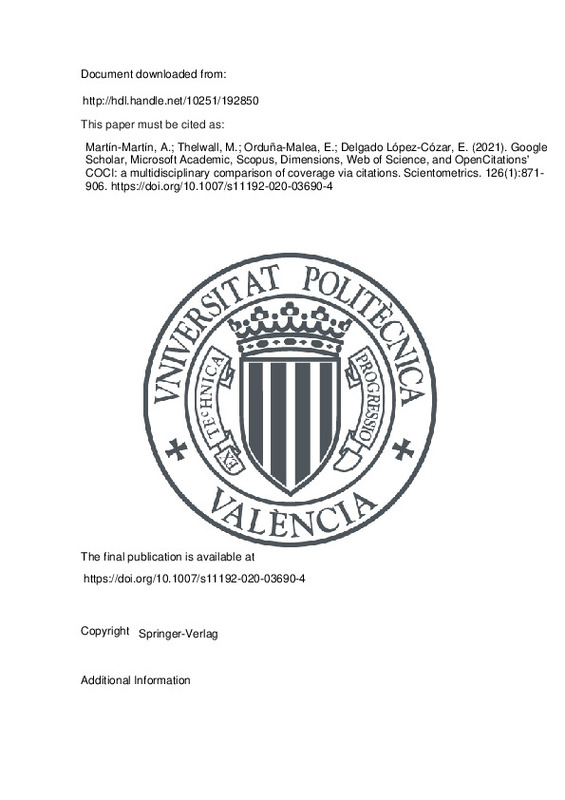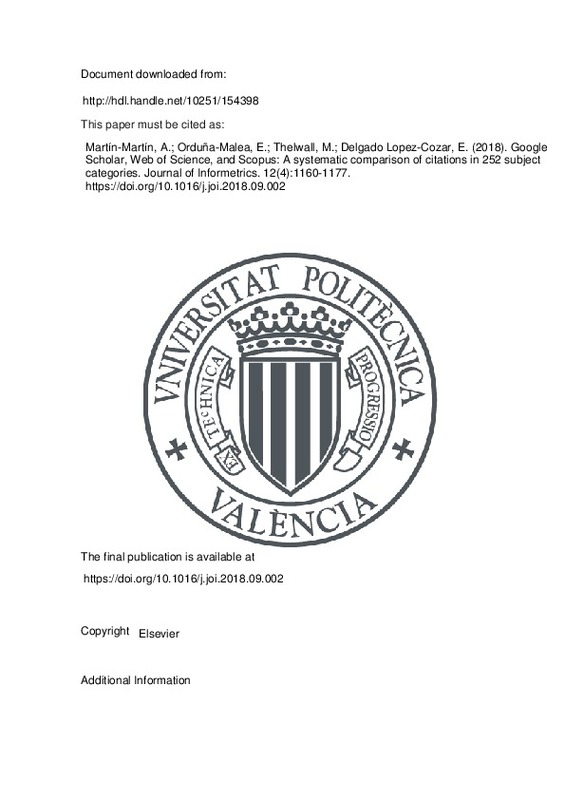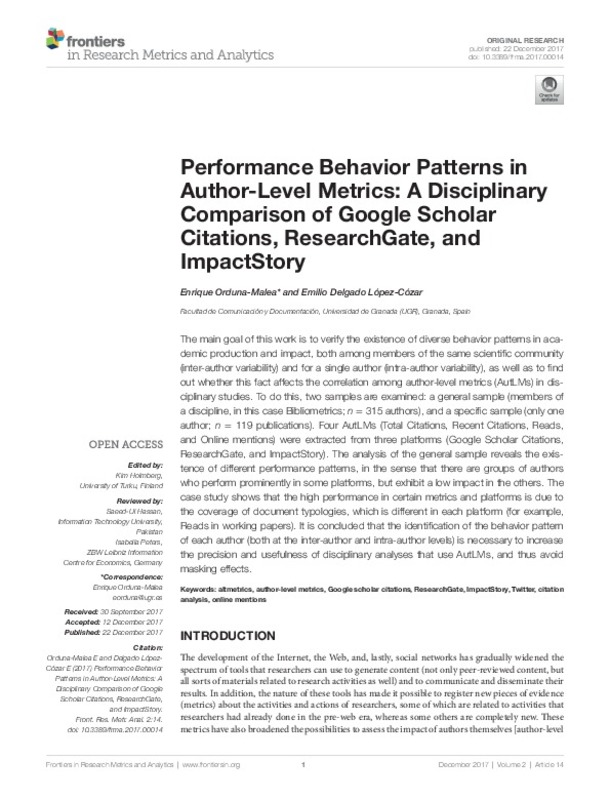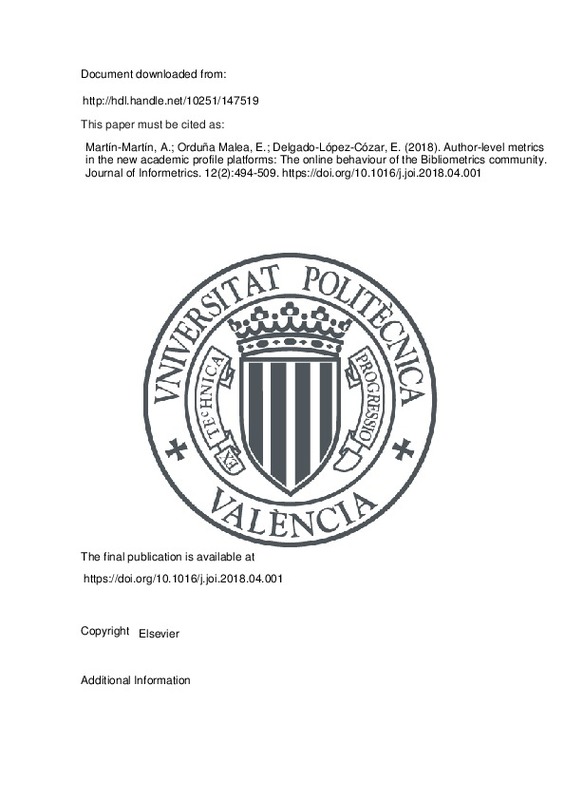JavaScript is disabled for your browser. Some features of this site may not work without it.
Buscar en RiuNet
Listar
Mi cuenta
Estadísticas
Ayuda RiuNet
Admin. UPV
Google Scholar, Microsoft Academic, Scopus, Dimensions, Web of Science, and OpenCitations' COCI: a multidisciplinary comparison of coverage via citations
Mostrar el registro sencillo del ítem
Ficheros en el ítem
| dc.contributor.author | Martín-Martín, Alberto
|
es_ES |
| dc.contributor.author | Thelwall, Mike
|
es_ES |
| dc.contributor.author | Orduña-Malea, Enrique
|
es_ES |
| dc.contributor.author | Delgado López-Cózar, Emilio
|
es_ES |
| dc.date.accessioned | 2023-04-19T18:01:20Z | |
| dc.date.available | 2023-04-19T18:01:20Z | |
| dc.date.issued | 2021-01 | es_ES |
| dc.identifier.issn | 0138-9130 | es_ES |
| dc.identifier.uri | http://hdl.handle.net/10251/192850 | |
| dc.description.abstract | [EN] New sources of citation data have recently become available, such as Microsoft Academic, Dimensions, and the OpenCitations Index of CrossRef open DOI-to-DOI citations (COCI). Although these have been compared to the Web of Science Core Collection (WoS), Scopus, or Google Scholar, there is no systematic evidence of their differences across subject categories. In response, this paper investigates 3,073,351 citations found by these six data sources to 2,515 English-language highly-cited documents published in 2006 from 252 subject categories, expanding and updating the largest previous study. Google Scholar found 88% of all citations, many of which were not found by the other sources, and nearly all citations found by the remaining sources (89-94%). A similar pattern held within most subject categories. Microsoft Academic is the second largest overall (60% of all citations), including 82% of Scopus citations and 86% of WoS citations. In most categories, Microsoft Academic found more citations than Scopus and WoS (182 and 223 subject categories, respectively), but had coverage gaps in some areas, such as Physics and some Humanities categories. After Scopus, Dimensions is fourth largest (54% of all citations), including 84% of Scopus citations and 88% of WoS citations. It found more citations than Scopus in 36 categories, more than WoS in 185, and displays some coverage gaps, especially in the Humanities. Following WoS, COCI is the smallest, with 28% of all citations. Google Scholar is still the most comprehensive source. In many subject categories Microsoft Academic and Dimensions are good alternatives to Scopus and WoS in terms of coverage. | es_ES |
| dc.description.sponsorship | We thank Medialab UGR (Universidad de Granada) for providing funding to cover the cost of hosting the interactive web application54 created to explore the data used in this study. We thank Digital Science for providing free access to the Dimensions API. We thank Jing Xuan Xie for translating the abstract to Chinese. We thank Asura Enkhbayar for suggesting the use of an upset plot in Fig. 2. Lastly, we thank two anonymous reviewers for their thoughtful comments, which have helped improved the manuscript | es_ES |
| dc.language | Inglés | es_ES |
| dc.publisher | Springer-Verlag | es_ES |
| dc.relation.ispartof | Scientometrics | es_ES |
| dc.rights | Reserva de todos los derechos | es_ES |
| dc.subject | Google Scholar | es_ES |
| dc.subject | Microsoft Academic | es_ES |
| dc.subject | Scopus | es_ES |
| dc.subject | Dimensions | es_ES |
| dc.subject | Web of Science | es_ES |
| dc.subject | OpenCitations | es_ES |
| dc.subject | COCI | es_ES |
| dc.subject | CrossRef | es_ES |
| dc.subject | Coverage | es_ES |
| dc.subject | Citations | es_ES |
| dc.subject | Bibliometrics | es_ES |
| dc.subject | Citation analysis | es_ES |
| dc.subject | Bibliographic databases | es_ES |
| dc.subject | Literature reviews | es_ES |
| dc.subject.classification | BIBLIOTECONOMIA Y DOCUMENTACION | es_ES |
| dc.title | Google Scholar, Microsoft Academic, Scopus, Dimensions, Web of Science, and OpenCitations' COCI: a multidisciplinary comparison of coverage via citations | es_ES |
| dc.type | Artículo | es_ES |
| dc.identifier.doi | 10.1007/s11192-020-03690-4 | es_ES |
| dc.rights.accessRights | Abierto | es_ES |
| dc.contributor.affiliation | Universitat Politècnica de València. Facultad de Bellas Artes - Facultat de Belles Arts | es_ES |
| dc.description.bibliographicCitation | Martín-Martín, A.; Thelwall, M.; Orduña-Malea, E.; Delgado López-Cózar, E. (2021). Google Scholar, Microsoft Academic, Scopus, Dimensions, Web of Science, and OpenCitations' COCI: a multidisciplinary comparison of coverage via citations. Scientometrics. 126(1):871-906. https://doi.org/10.1007/s11192-020-03690-4 | es_ES |
| dc.description.accrualMethod | S | es_ES |
| dc.relation.publisherversion | https://doi.org/10.1007/s11192-020-03690-4 | es_ES |
| dc.description.upvformatpinicio | 871 | es_ES |
| dc.description.upvformatpfin | 906 | es_ES |
| dc.type.version | info:eu-repo/semantics/publishedVersion | es_ES |
| dc.description.volume | 126 | es_ES |
| dc.description.issue | 1 | es_ES |
| dc.relation.pasarela | S\426132 | es_ES |
| dc.contributor.funder | Universidad de Granada | es_ES |
| dc.description.references | Baas, J., Schotten, M., Plume, A., Côté, G., & Karimi, R. (2020). Scopus as a curated, high-quality bibliometric data source for academic research in quantitative science studies. Quantitative Science Studies, 1(1), 377–386. https://doi.org/10.1162/qss_a_00019. | es_ES |
| dc.description.references | Beel, J., & Gipp, B. (2009a). Google Scholar’s ranking algorithm: The impact of articles’ age (an empirical study). Sixth International Conference on Information Technology: New Generations, 2009, 160–164. https://doi.org/10.1109/ITNG.2009.317. | es_ES |
| dc.description.references | Beel, J., & Gipp, B. (2009b). Google Scholar’s ranking algorithm: The impact of citation counts (An empirical study). Third International Conference on Research Challenges in Information Science, 2009, 439–446. https://doi.org/10.1109/RCIS.2009.5089308. | es_ES |
| dc.description.references | Beel, J., & Gipp, B. (2009c). Google Scholar’s ranking algorithm: An introductory overview. In Proceedings of the 12th International Conference on Scientometrics and Informetrics (ISSI’09) (pp. 230–241). http://www.issi-society.org/proceedings/issi_2009/ISSI2009-proc-vol1_Aug2009_batch2-paper-1.pdf | es_ES |
| dc.description.references | Birkle, C., Pendlebury, D. A., Schnell, J., & Adams, J. (2020). Web of Science as a data source for research on scientific and scholarly activity. Quantitative Science Studies, 1(1), 363–376. https://doi.org/10.1162/qss_a_00018. | es_ES |
| dc.description.references | Chapman, K., & Ellinger, A. E. (2019). An evaluation of Web of Science, Scopus and Google Scholar citations in operations management. The International Journal of Logistics Management, 30(4), 1039–1053. https://doi.org/10.1108/IJLM-04-2019-0110. | es_ES |
| dc.description.references | Damerau, F. J. (1964). A technique for computer detection and correction of spelling errors. Communications of the ACM, 7(3), 171–176. https://doi.org/10.1145/363958.363994. | es_ES |
| dc.description.references | Delgado López-Cózar, E., & Martín-Martín, A. (2018). Apagón digital de la producción científica española en Google Scholar. Anuario ThinkEPI, 12, 265–276. https://doi.org/10.3145/thinkepi.2018.40. | es_ES |
| dc.description.references | Delgado López-Cózar, E., Orduna-Malea, E., & Martín-Martín, A. (2019). Google Scholar as a data source for research assessment. In W. Glaenzel, H. Moed, U. Schmoch, & M. Thelwall (Eds.), Springer handbook of science and technology indicators. Berlin: Springer. | es_ES |
| dc.description.references | Dowle, M., Srinivasan, A., Gorecki, J., Chirico, M., Stetsenko, P., Short, T., Lianoglou, S., Antonyan, E., Bonsch, M., & Parsonage, H. (2018). data.table: Extension of ‘data.frame’ (1.11.4). | es_ES |
| dc.description.references | Else, H. (2018, April 11). How I scraped data from Google Scholar. Nature. https://doi.org/10.1038/d41586-018-04190-5 | es_ES |
| dc.description.references | Forveille, T. (2019). A&A ranking by Google. Astronomy & Astrophysics, 628, E1. https://doi.org/10.1051/0004-6361/201936429. | es_ES |
| dc.description.references | Fraser, N., Brierley, L., Dey, G., Polka, J. K., Pálfy, M., & Coates, J. A. (2020). Preprinting a pandemic: The role of preprints in the COVID-19 pandemic. BioRxiv, 2020.05.22.111294. https://doi.org/10.1101/2020.05.22.111294 | es_ES |
| dc.description.references | Gusenbauer, M. (2018). Google Scholar to overshadow them all? Comparing the sizes of 12 academic search engines and bibliographic databases. Scientometrics. https://doi.org/10.1007/s11192-018-2958-5. | es_ES |
| dc.description.references | Gusenbauer, M., & Haddaway, N. R. (2020). Which academic search systems are suitable for systematic reviews or meta-analyses? Evaluating retrieval qualities of Google Scholar, PubMed, and 26 other resources. Research Synthesis Methods, 11(2), 181–217. https://doi.org/10.1002/jrsm.1378. | es_ES |
| dc.description.references | Haddaway, N., & Gusenbauer, M. (2020, February 3). A broken system: Why literature searching needs a FAIR revolution. Impact of Social Sciences. https://blogs.lse.ac.uk/impactofsocialsciences/2020/02/03/a-broken-system-why-literature-searching-needs-a-fair-revolution/. | es_ES |
| dc.description.references | Halevi, G., Moed, H., & Bar-Ilan, J. (2017). Suitability of Google Scholar as a source of scientific information and as a source of data for scientific evaluation—Review of the Literature. Journal of Informetrics, 11(3), 823–834. https://doi.org/10.1016/J.JOI.2017.06.005. | es_ES |
| dc.description.references | Harzing, A. W. (2016). Microsoft Academic (Search): A Phoenix arisen from the ashes? In Scientometrics (Vol. 108, No. 3, pp. 1637–1647). Springer, Netherlands. https://doi.org/10.1007/s11192-016-2026-y | es_ES |
| dc.description.references | Harzing, A.-W. (2016). Sacrifice a little accuracy for a lot more comprehensive coverage. Harzing.Com. https://harzing.com/blog/2016/08/sacrifice-a-little-accuracy-for-a-lot-more-comprehensive-coverage | es_ES |
| dc.description.references | Harzing, A. W. (2019). Two new kids on the block: How do Crossref and Dimensions compare with Google Scholar, Microsoft Academic, Scopus and the Web of Science? In Scientometrics (Vol. 120, Issue 1, pp. 341–349). Springer, Netherlands. https://doi.org/10.1007/s11192-019-03114-y | es_ES |
| dc.description.references | Harzing, A.-W., & Alakangas, S. (2016). Google Scholar, Scopus and the Web of Science: A longitudinal and cross-disciplinary comparison. Scientometrics, 106(2), 787–804. https://doi.org/10.1007/s11192-015-1798-9. | es_ES |
| dc.description.references | Harzing, A. W., & Alakangas, S. (2017a). Microsoft Academic: Is the phoenix getting wings? In Scientometrics (Vol. 110, Issue 1, pp. 371–383). Springer, Netherlands. https://doi.org/10.1007/s11192-016-2185-x | es_ES |
| dc.description.references | Harzing, A. W., & Alakangas, S. (2017b). Microsoft Academic is one year old: The Phoenix is ready to leave the nest. In Scientometrics (Vol. 112, Issue 3, pp. 1887–1894). Springer, Netherlands. https://doi.org/10.1007/s11192-017-2454-3 | es_ES |
| dc.description.references | Haunschild, R., Hug, S. E., Brändle, M. P., & Bornmann, L. (2018). The number of linked references of publications in Microsoft Academic in comparison with the Web of Science. In Scientometrics (Vol. 114, Issue 1, pp. 367–370). Springer, Netherlands. https://doi.org/10.1007/s11192-017-2567-8 | es_ES |
| dc.description.references | Heibi, I., Peroni, S., & Shotton, D. (2019). Software review: COCI, the OpenCitations Index of Crossref open DOI-to-DOI citations. Scientometrics. https://doi.org/10.1007/s11192-019-03217-6. | es_ES |
| dc.description.references | Hendricks, G., Tkaczyk, D., Lin, J., & Feeney, P. (2020). Crossref: The sustainable source of community-owned scholarly metadata. Quantitative Science Studies, 1(1), 414–427. https://doi.org/10.1162/qss_a_00022. | es_ES |
| dc.description.references | Herzog, C., Hook, D., & Konkiel, S. (2020). Dimensions: Bringing down barriers between scientometricians and data. Quantitative Science Studies, 1(1), 387–395. https://doi.org/10.1162/qss_a_00020. | es_ES |
| dc.description.references | Hook, D. W., Porter, S. J., & Herzog, C. (2018). Dimensions: Building Context for Search and Evaluation. Frontiers in Research Metrics and Analytics, 3, 23. https://doi.org/10.3389/frma.2018.00023. | es_ES |
| dc.description.references | Huang, C.-K., Neylon, C., Brookes-Kenworthy, C., Hosking, R., Montgomery, L., Wilson, K., et al. (2020). Comparison of bibliographic data sources: Implications for the robustness of university rankings. Quantitative Science Studies. https://doi.org/10.1162/qss_a_00031. | es_ES |
| dc.description.references | Hug, S. E., & Brändle, M. P. (2017). The coverage of Microsoft Academic: Analyzing the publication output of a university. Scientometrics, 113(3), 1551–1571. https://doi.org/10.1007/s11192-017-2535-3. | es_ES |
| dc.description.references | Kousha, K., & Thelwall, M. (2018). Can Microsoft Academic help to assess the citation impact of academic books? Journal of Informetrics, 12(3), 972–984. https://doi.org/10.1016/j.joi.2018.08.003. | es_ES |
| dc.description.references | Kousha, K., Thelwall, M., & Abdoli, M. (2018). Can Microsoft Academic assess the early citation impact of in-press articles? A multi-discipline exploratory analysis. Journal of Informetrics, 12(1), 287–298. https://doi.org/10.1016/j.joi.2018.01.009. | es_ES |
| dc.description.references | Krassowski, M. (2020). ComplexUpset. https://github.com/krassowski/complex-upset | es_ES |
| dc.description.references | Larsson, J., Godfrey, A. J. R., Kelley, T., Eberly, D. H., Gustafsson, P., & Huber, E. (2018). eulerr: Area-Proportional Euler and Venn Diagrams with Circles or Ellipses (4.1.0). | es_ES |
| dc.description.references | Levenshtein, V. I. (1966). Binary codes capable of correcting deletions, insertions, and reversals. Soviet Physics Doklady, 10(8), 707–710. | es_ES |
| dc.description.references | Martín-Martín, A. (2018). Code to extract bibliographic data from Google Scholar (v1.0). Zenodo. https://doi.org/10.5281/zenodo.1481076 | es_ES |
| dc.description.references | Martín-Martín, A., & Delgado López-Cózar, E. (2016). Reading Web of Science data into R (0.6). | es_ES |
| dc.description.references | Martin-Martin, A., Orduna-Malea, E., Harzing, A.-W., & Delgado López-Cózar, E. (2017). Can we use Google Scholar to identify highly-cited documents? Journal of Informetrics, 11(1), 152–163. https://doi.org/10.1016/j.joi.2016.11.008. | es_ES |
| dc.description.references | Martín-Martín, A., Orduna-Malea, E., Thelwall, M., & Delgado López-Cózar, E. (2018). Google Scholar, Web of Science, and Scopus: A systematic comparison of citations in 252 subject categories. Journal of Informetrics, 12(4), 1160–1177. https://doi.org/10.1016/J.JOI.2018.09.002. | es_ES |
| dc.description.references | Moed, H. F., Bar-Ilan, J., & Halevi, G. (2016). A new methodology for comparing Google Scholar and Scopus. Journal of Informetrics, 10(2), 533–551. https://doi.org/10.1016/j.joi.2016.04.017. | es_ES |
| dc.description.references | Orduña-Malea, E., & Delgado-López-Cózar, E. (2018). Dimensions: Re-discovering the ecosystem of scientific information. Profesional de La Informacion, 27(2), 420–431. https://doi.org/10.3145/epi.2018.mar.21. | es_ES |
| dc.description.references | Orduña-Malea, E., Martín-Martín, A., Ayllon, M., & Delgado López-Cózar, E. (2014). The silent fading of an academic search engine: The case of Microsoft Academic Search. Online Information Review, 38(7), 936–953. https://doi.org/10.1108/OIR-07-2014-0169. | es_ES |
| dc.description.references | Orduña-Malea, E., Martín-Martín, A., Ayllón, J. M., & Delgado López-Cózar, E. (2016). La revolución Google Scholar: Destapando la caja de Pandora académica. Universidad de Granada y Unión de Editoriales Universitarias Españolas. | es_ES |
| dc.description.references | Orduna-Malea, E., Martín-Martín, A., & Delgado López-Cózar, E. (2017). Google Scholar as a source for scholarly evaluation: A bibliographic review of database errors. Revista Española de Documentación Científica, 40(4), e185. https://doi.org/10.3989/redc.2017.4.1500. | es_ES |
| dc.description.references | Orduna-Malea, E., Martín-Martín, A., & Delgado López-Cózar, E. (2018). Classic papers: Using Google Scholar to detect the highly-cited documents. In 23rd International conference on science and technology indicators (pp. 1298–1307). https://doi.org/10.31235/osf.io/zkh7p | es_ES |
| dc.description.references | Ortega, J. L. (2014). Academic search engines: A quantitative outlook. Cambridge: Chandos Publishing. | es_ES |
| dc.description.references | Peroni, S., & Shotton, D. (2020). OpenCitations, an infrastructure organization for open scholarship. Quantitative Science Studies, 1(1), 428–444. https://doi.org/10.1162/qss_a_00023. | es_ES |
| dc.description.references | R Core Team. (2014). R: A Language and Environment for Statistical Computing. | es_ES |
| dc.description.references | Rovira, C., Codina, L., Guerrero-Solé, F., & Lopezosa, C. (2019). Ranking by relevance and citation counts, a comparative study: Google Scholar, Microsoft academic, WoS and scopus. Future Internet, 11(9), 202. https://doi.org/10.3390/fi11090202. | es_ES |
| dc.description.references | Shotton, D. (2013). Publishing: Open citations. Nature, 502(7471), 295–297. https://doi.org/10.1038/502295a. | es_ES |
| dc.description.references | Shotton, D. (2018). Funders should mandate open citations. Nature, 553(7687), 129. https://doi.org/10.1038/d41586-018-00104-7. | es_ES |
| dc.description.references | Tay, A. (2019, April 3). 6 reasons why you should try Lens.org. Medium. https://medium.com/@aarontay/6-reasons-why-you-should-try-lens-org-c40abb09ec6f | es_ES |
| dc.description.references | Thelwall, M. (2017). Microsoft Academic: A multidisciplinary comparison of citation counts with Scopus and Mendeley for 29 journals. Journal of Informetrics, 11(4), 1201–1212. https://doi.org/10.1016/j.joi.2017.10.006. | es_ES |
| dc.description.references | Thelwall, M. (2018a). Does Microsoft Academic find early citations? Scientometrics, 114(1), 325–334. https://doi.org/10.1007/s11192-017-2558-9. | es_ES |
| dc.description.references | Thelwall, M. (2018b). Microsoft Academic automatic document searches: Accuracy for journal articles and suitability for citation analysis. Journal of Informetrics, 12(1), 1–9. https://doi.org/10.1016/j.joi.2017.11.001. | es_ES |
| dc.description.references | Thelwall, M. (2018c). Dimensions: A competitor to Scopus and the Web of Science? Journal of Informetrics, 12(2), 430–435. https://doi.org/10.1016/j.joi.2018.03.006. | es_ES |
| dc.description.references | van der Loo, M., van der Laan, J., R Core Team, Logan, N., & Muir, C. (2018). stringdist: Approximate String Matching and String Distance Functions (0.9.5.1). | es_ES |
| dc.description.references | van Eck, N. J., & Waltman, L. (2019). Accuracy of citation data in Web of Science and Scopus. | es_ES |
| dc.description.references | van Eck, N. J., Waltman, L., Larivière, V., & Sugimoto, C. (2018). Crossref as a new source of citation data: A comparison with Web of Science and Scopus. https://www.cwts.nl/blog?article=n-r2s234&title=crossref-as-a-new-source-of-citation-data-a-comparison-with-web-of-science-and-scopus | es_ES |
| dc.description.references | Van Noorden, R. (2014). November 7). Google Scholar pioneer on search engine’s future. Nature.. https://doi.org/10.1038/nature.2014.16269. | es_ES |
| dc.description.references | Visser, M., van Eck, N. J., & Waltman, L. (2020). Large-scale comparison of bibliographic data sources: Scopus, Web of Science, Dimensions, Crossref, and Microsoft Academic. https://arxiv.org/abs/2005.10732 | es_ES |
| dc.description.references | Walker, A., & Braglia, L. (2018). openxlsx: Read, Write and Edit XLSX Files (4.1.0). | es_ES |
| dc.description.references | Wang, K., Shen, Z., Huang, C., Wu, C.-H., Dong, Y., & Kanakia, A. (2020). Microsoft academic graph: When experts are not enough. Quantitative Science Studies, 1(1), 396–413. https://doi.org/10.1162/qss_a_00021. | es_ES |
| dc.description.references | Wickham, H. (2016). ggplot2: Elegant graphics for data analysis. New York: Springer. | es_ES |
| dc.description.references | Wilke, C. O. (2019). cowplot: Streamlined Plot Theme and Plot Annotations for ‘ggplot2′. | es_ES |
| dc.description.references | Wu, J., Kim, K., & Giles, C. L. (2019). CiteSeerX: 20 years of service to scholarly big data. Proceedings of the Conference on Artificial Intelligence for Data Discovery and Reuse. https://doi.org/10.1145/3359115.3359119. | es_ES |







![[Cerrado]](/themes/UPV/images/candado.png)




